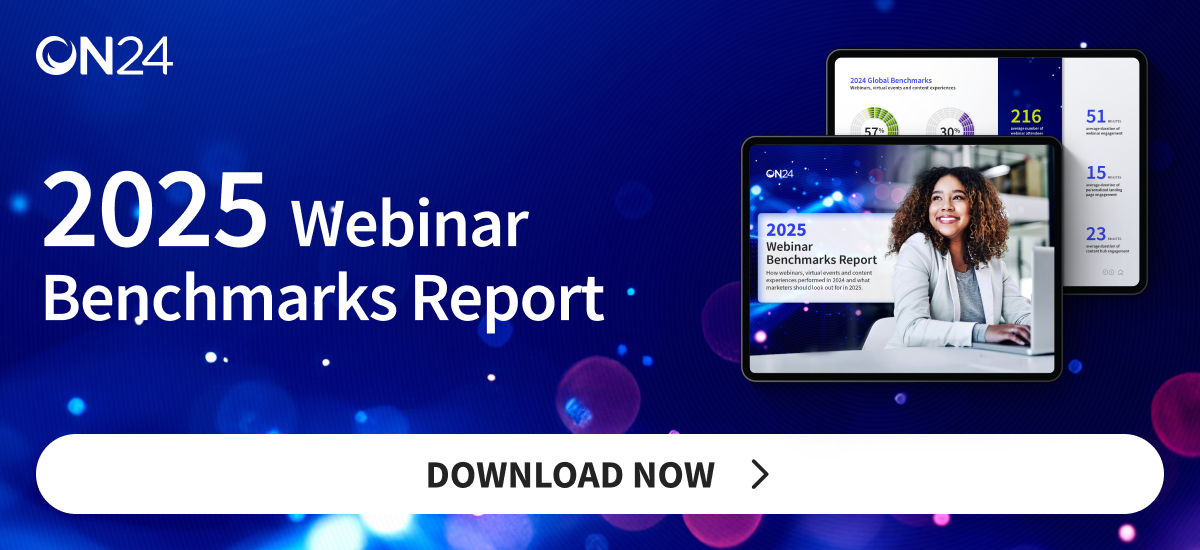Overview
-
Expand Reach and Engagement
Hybrid events combine physical and digital experiences to reach larger, global audiences — offering interactive features like Q&A, panels, and breakout sessions to boost participation.
-
Enhance Interactivity Through Tangible and Digital Assets
Incorporating elements like workbooks, certificates, and downloadable materials keeps virtual attendees engaged and helps translate hands-on, in-person experiences into hybrid formats.
-
Recreate In-Person Energy Virtually
By using tools like interactive maps, live interviews, and digital swag, hybrid events can replicate the excitement and connection of live gatherings — driving sustained engagement and post-event buzz.
Few things are as fulfilling as seeing a packed house, sold-out tickets, rave reviews, outstanding speaking sessions and off-the-chart engagements when you work events.
But what if you want more? How can you scale events so they impact more audiences in more places without the extra work?
Hybrid events empower you to do exactly that. With a digital-first approach, your audience is — pardon the pun — virtually limitless, as is your engagement with attendees. That’s because hybrid events expand the number of seats available to you and your audience while also providing experiences on-demand — either during the live event or on an attendee’s own time after the live event is over.
Hybrid events empower you to share more content, drive more engagement, and combine the best of both physical and virtual worlds. Here are four examples of how incorporating hybrid events into your event strategy can help drive even more engagement.
1) Extending Your Event’s Reach

Ever feel like more people would’ve attended an in-person event if it were easier to get to? What about if you had more room at your physical space?
Thomson Reuters asked itself these questions during its annual “Risk and Compliance Summit” in London, which regularly brought in 600 C-level industry delegates.
However, the company wanted to attract a larger audience and expand its reach beyond the U.K.
Normally, this would mean organizing expensive gatherings in other locations or pushing summit to attendees online. But Thomson Reuters added a virtual component to its London summit.
With ON24, Thomson Reuters created a hybrid event that pushed its physical summit to continental Europe. Digital attendees experienced the same look, feel and content as the physical summit but without the need for travel.
Featuring everything from Q&A chats with experts to break-out sessions for live discussion, the event saw:
-
- A larger number of c-level contacts who couldn’t afford the time to travel to a physcial venue
- A seamless transfer of aesthetics from physical to online events
- A 90% satisfaction rate from attendees
Something to Think About: Run a panel discussion
A panel discussion is simply a discussion among about three subject experts, moderated by a presenter.
How to do it: Find a few favorite contacts who are reliable, knowledgeable, and great at communicating. They might be clients of the company or industry experts. The presenter, although moderating, should also be well-versed so they can guide the discussion and think of different angles on the fly.
The discussion will be more lively and could yield more interesting insights, including offering several different approaches to a single problem, if the panelists have differing opinions. A diverse panel makes for a greater conversation and provides a broader appeal to your audience.
Before going live, create a list of discussion topics to keep things moving and on track. Let the panel know in advance so they can prepare.
2) Running A Workshop

In-person events provide strong engagement and relationship-building opportunities.
These same opportunities, however, are more challenging with virtual and hybrid events. Keeping participants engaged takes effort to maintain or, in some cases, regain attention.
Tune virtual audiences back in with tangible assets or activities. It could be a cooking class, a puzzle, pretty much anything requiring conscious movement on the part of your viewers — in real time.
For example, ON24 hosted a hybrid event incorporating a tactile element, which kept audiences focused throughout the event. We sent attendees of “The Predictable Pipeline Workshop,” a workbook, which could be downloaded or printed, so participants could fill out worksheets as the event progressed.
By asking attendees to complete activities in the book, we saw an uptick in interactions and more engaged responses from the audience.
Something To Think About: Do a Content recap / revisit
What it is: A new look at an old subject which may have been rendered relevant with recent events, such as a change in legislation.
How to do it: Bring together all the material from the old webinar, including slides, audience data and ad creative. Update anything that has gone out of date.
You’ve got a head start on promotion here – target all those who watched the webinar last time, and refresh the ad creative that worked best if you decide to take the paid social route.
3) Showcasing a Physical Asset

You can also use physical assets — like a downloadable e-book — to draw people in to complete your webinar or hybrid event.
Certificates are a simple way to accomplish this. Award virtual attendees with printable certificates for completing training and courses to motivate them to stay engaged with your content.
Hybrid lessons are also a clever way to save on the costs of in-person training.
To do so, you could create webinars featuring a mix of videos, slides and downloadable resources, like PDFs, and offer the option for participants to engage in a Q&A at any time throughout the training.
After passing a quiz virtual attendees can download the certificate from the webinar and share on social media platform to showcase expertise and commitment to continuing education.\
In other cases, you can make the physical asset the star of the show.
Australia’s La Trobe University made higher education more accessible to students in Melbourne and the surrounding region through a virtual “Open Day” event. This event gave current and prospective students a chance to learn more about courses and careers, tour campuses, interact with staff, and learn about scholarships, housing, and more.
Previously held on campus and in-person the annual event generates a large chunk of yearly enrollment. But, there were concerns with how to transition from physical to virtual while still conveying the university experience in an impactful way.
Tapping into ON24, La Trobe created an interactive space where students could virtually tour the campus and gain all the same information as they would have in person. Live hosts managed Q&As in real-time, both written and verbally.
La Trobe coordinated and recorded 100 sessions in eight weeks to prepare for the event, and saw a 167% increase over the previous year’s event — maintaining enrollment numbers despite the shift to learning at home during the pandemic.
Something to Think About: Schedule a product demo
What it is: A look at how certain features of your product work, presented by an expert.
If your customers have a common problem that can be solved by your product, a product demo could show them a solution, while showcasing your product to a clutch of new potential customers.
How to do it: Base the webinar around a particular problem that the solution can help users solve, rather than giving a tour of the entire product, which might come off as a pitch. The approach may also alert potential customers to problems they might not even know they had.
Find someone on your team who knows the product inside out, can clearly communicate complicated concepts and who won’t be thrown by unexpected questions from the audience.
ON24’s Mark Bornstein terms these sessions “The Deminar.” Taking this approach allows you to have a conversation as you present, and therefore act as great bottom-of-funnel webinars.
Webinars like these have great simulive potential – that is, you can run them again and again as live ensuring that new customers also get to see them. And by putting your sales team on Q&A duty, you can have them engage in real-time even when you aren’t actually presenting.
For accounting firm Sage, their daily “Coffee Break Demo” sees more than 20 sign-ups a day on average — meaning they generate as many opportunities from this automated session as all their other webinars combined.
4) Creating an In-Person Experience Anywhere and Anytime

Plan your next hybrid event design to bring audiences right into the thick of the action by incorporating real-time interactions, breakout sessions, virtual booths, and swag.
In our own “Beyond the Webinar,” virtual trade show, we showcased what ON24 has to offer while emulating an in-person experience.
But how would you design this?
Just as you would map out the various components of an in-person event, drawing out experience maps of your virtual environment can help make sense of all you have going on in your virtual space.
Start with a representation of the event flow, then move on to specific elements like an interactive map, clickable images, or highlighted opportunities for people to engage with one another. Other options could include a resource center or breakout sessions aligning with your in-person offering.
Finally, don’t forget that everyone loves swag. Tap into some simple giveaways to draw attention to your hybrid event, spicing things up at lulls and keeping the conversation going even after things have wrapped up.
Before, during, or after the event, free stuff encourages attendance and injects fun into your event — and often helps to drive some buzz around your event on social media.
Something to Think About: Interview Your Boss, a Co-Worker or a Client
What it is: A chat with one of the company’s highest-ranking personnel, such as the CEO or Chief Product Officer, or with one of the company’s clients. Remember, this can be recorded in advance.
How to do it: Recruit a member of your team who is comfortable in front of the camera and may have some interviewing experience.
Draft a set of about 10 questions to put to your interviewee – you won’t need to ask all of these, in fact, you’ll probably only have time to ask more than in 45 minutes, but 10 gives you some room for maneuver. You might talk to a client about how they’ve used your product or service, or a member of your C-suite about upcoming opportunities, threats and trends in the industry. Make sure to engage the audience too, and field their questions as much as possible.
Share these with the interviewee in advance so that they can prepare, and make any suggestions – as they’re experts, they may have great ideas for discussion you may have missed. Read our article on interview webinar tips for more guidance.
Whatever you do in your hybrid event design, remember that when done well, bridging the gap between the physical and the virtual helps to draw in a more engaged audience, encourages thoughtful interaction and can extend the reach of your programs.




